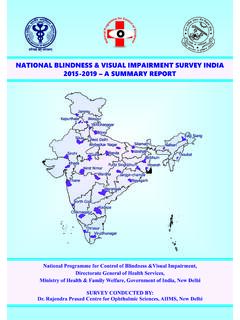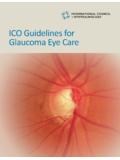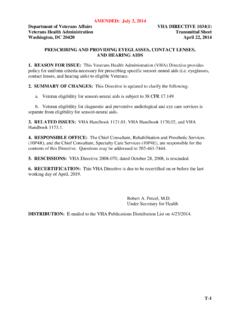Transcription of IMPACT OF INCREASING THE IMPACT OF MYOPIA …
1 For more information, please contact:Report of the Joint World Health Organization Brien Holden Vision Institute Global Scientific Meeting on MyopiaIMPACT OF INCREASING PREVALENCEOF MYOPIA AND HIGH MYOPIAaThe IMPACT of MYOPIA and high myopiaReport of the Joint World Health Organization Brien Holden Vision Institute Global Scientific Meeting on MyopiaTHE IMPACT OF MYOPIA AND HIGH MYOPIAU niversity of New South Wales, Sydney, Australia 16 18 March 2015 Report of the Joint World Health Organization Brien Holden Vision Institute Global Scientific Meeting on MyopiaTHE IMPACT OF MYOPIA AND HIGH MYOPIAU niversity of New South Wales, Sydney, Australia 16 18 March 2015 The IMPACT of MYOPIA and high MYOPIA : report of the Joint World Health Organization Brien Holden Vision Institute Global Scientific Meeting on MYOPIA , University of New South Wales, Sydney, Australia, 16 18 March 2015 ISBN 978-92-4-151119-3 World Health Organization 2017 Some rights reserved.
2 This work is available under the Creative Commons Attribution-NonCommercial-ShareAlike IGO licence (CC BY-NC-SA IGO; ). Under the terms of this licence, you may copy, redistribute and adapt the work for non-commercial purposes, provided the work is appropriately cited, as indicated below. In any use of this work, there should be no suggestion that WHO endorses any specific organization, products or services. The use of the WHO logo is not permitted. If you adapt the work, then you must license your work under the same or equivalent Creative Commons licence. If you create a translation of this work, you should add the following disclaimer along with the suggested citation: This translation was not created by the World Health Organization (WHO). WHO is not responsible for the content or accuracy of this translation.
3 The original English edition shall be the binding and authentic edition .Any mediation relating to disputes arising under the licence shall be conducted in accordance with the mediation rules of the World Intellectual Property citation. The IMPACT of MYOPIA and high MYOPIA : report of the Joint World Health Organization Brien Holden Vision Institute Global Scientific Meeting on MYOPIA , University of New South Wales, Sydney, Australia, 16 18 March 2015. Geneva: World Health Organization; 2017. Licence: CC BY-NC-SA (CIP) data. CIP data are available at , rights and licensing. To purchase WHO publications, see To submit requests for commercial use and queries on rights and licensing, see materials. If you wish to reuse material from this work that is attributed to a third party, such as tables, figures or images, it is your responsibility to determine whether permission is needed for that reuse and to obtain permission from the copyright holder.
4 The risk of claims resulting from infringement of any third-party-owned component in the work rests solely with the disclaimers. The designations employed and the presentation of the material in this publication do not imply the expression of any opinion whatsoever on the part of WHO concerning the legal status of any country, territory, city or area or of its authorities, or concerning the delimitation of its frontiers or boundaries. Dotted and dashed lines on maps represent approximate border lines for which there may not yet be full agreement. The mention of specific companies or of certain manufacturers products does not imply that they are endorsed or recommended by WHO in preference to others of a similar nature that are not mentioned. errors and omissions excepted, the names of proprietary products are distinguished by initial capital reasonable precautions have been taken by WHO to verify the information contained in this publication.
5 However, the published material is being distributed without warranty of any kind, either expressed or implied. The responsibility for the interpretation and use of the material lies with the reader. In no event shall WHO be liable for damages arising from its use. The named authors alone are responsible for the views expressed in this in Switzerland Designed by In s Communication v1 Executive summary Introduction .. Summary.. Agreed conclusions and recommendations .. Specific conclusions and recommendations .. 22 Background and purpose of the consultation 43 Global prevalence of MYOPIA 54 MYOPIA as a cause of vision impairment and blindness 75 Terminology and classification MYOPIA , high MYOPIA and pathologic MYOPIA .
6 Myopic macular degeneration .. 86 IMPACT of MYOPIA 107 Evidence for causes of MYOPIA Optical and environmental influences.. Genetics and parental history.. 128 Control of MYOPIA Optical control .. Time spent outdoors and behavioural influences .. Pharmacological and therapeutic control.. 15 ContentsFor more information, please contact:Report of the Joint World Health Organization Brien Holden Vision Institute Global Scientific Meeting on MyopiaIMPACT OF INCREASING PREVALENCEOF MYOPIA AND HIGH MYOPIAivThe IMPACT of MYOPIA and high myopia9 Research Epidemiology of MYOPIA .
7 Myopigenesis, environmental, optical and therapeutic factors .. Risk factors and individual heterogeneity .. High MYOPIA , pathologic MYOPIA and comorbid conditions.. Eye examinations in MYOPIA .. 1810 Conclusions 19 References 20 Annex 1 Participants 25 Annex 2 Programme 26 Annex 3 Regions defined in the WHO Global Burden of Disease programme 29 For more information, please contact.
8 Report of the Joint World Health Organization Brien Holden Vision Institute Global Scientific Meeting on MyopiaIMPACT OF INCREASING PREVALENCEOF MYOPIA AND HIGH MYOPIAvThe IMPACT of MYOPIA and high myopiaAcknowledgementsThanks go to the authors of this report: Brien A. Holden, the Chair of the meeting; Silvio P. Mariotti, Ivo Kocur, Serge Resnikoff and Mingguang He, the Chairs of the individual sessions; Kovin Naidoo, the Rapporteur; Monica Jong, the scientific secretary; and the participants listed in Annex 1. Thanks are likewise due to the Australian Government, WHO, the Brien Holden Vision Institute, the Vision Cooperative Research Centre and scientists and professionals who supported this meeting, and the staff of the Brien Holden Vision Institute and WHO who organized the more information, please contact:Report of the Joint World Health Organization Brien Holden Vision Institute Global Scientific Meeting on MyopiaIMPACT OF INCREASING PREVALENCEOF MYOPIA AND HIGH MYOPIAviThe IMPACT of MYOPIA and high myopiaFor more information, please contact:Report of the Joint World Health Organization Brien Holden Vision Institute Global Scientific Meeting on MyopiaIMPACT OF INCREASING PREVALENCEOF MYOPIA AND HIGH MYOPIA1 The IMPACT of MYOPIA and high myopia1.
9 Executive IntroductionThe prevalence of MYOPIA and high MYOPIA are INCREASING globally at an alarming rate, with significant increases in the risks for vision impairment from pathologic conditions associated with high MYOPIA , including retinal damage, cataract and glaucoma. The IMPACT of MYOPIA is difficult to determine, because there are no standard definitions of MYOPIA and high MYOPIA , and recognition that MYOPIA can lead to vision impairment is limited by the absence of a defined category of myopic retinal disease that causes permanent vision impairment. A further impediment to progress in this area is insufficient evidence of the efficacy of various methods for controlling view of concern about the current and future IMPACT of MYOPIA , the Minister of Health for Australia, the Right Honourable Mr Peter Dutton, contacted the Director-General of WHO, Dr Margaret Chan, to request the involvement of WHO in an international scientific meeting on MYOPIA to be held by the Brien Holden Vision Institute (BHVI).
10 As a result, a three-day joint WHO BHVI meeting was convened on 16 18 March 2015 at the University of New South Wales in Sydney, SummaryScientific and clinical experts in MYOPIA were invited from all six WHO regions (see Annex 1). Keynote presentations, working groups and plenary sessions were held to review the evidence on the major issues in MYOPIA . The results of these deliberations were reported to plenary for discussion, and agreement was reached on a series of statements, definitions and priorities for Agreed conclusions and recommendations The group agreed on definitions of MYOPIA and high MYOPIA and on a category for and description of the pathologic consequences of MYOPIA . The epidemiological surveys currently used to measure the status of vision ( the WHO protocol and Rapid Assessment of Avoidable blindness ) do not allow the definition of high MYOPIA as a possible cause of vision impairment, partly because these surveys do not include a description of this condition or any measurement of refractive error.















